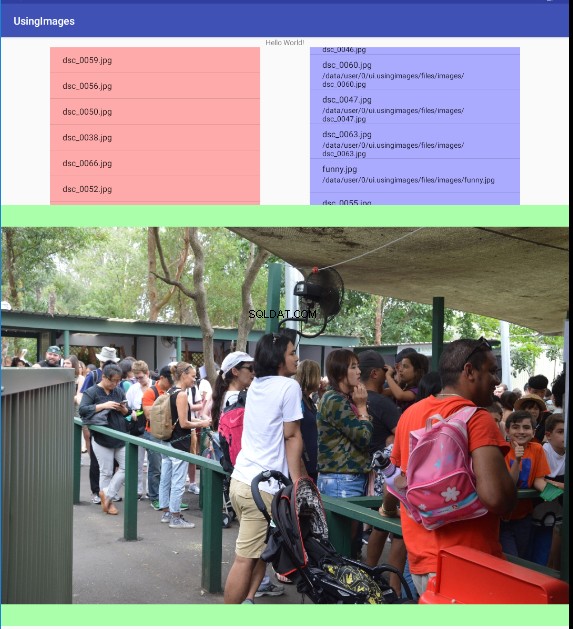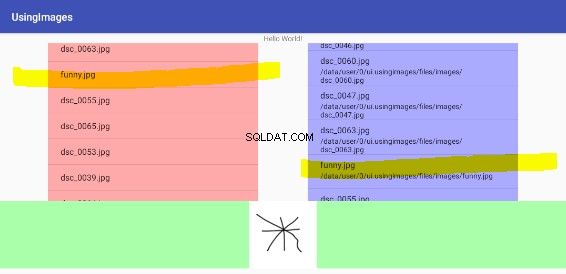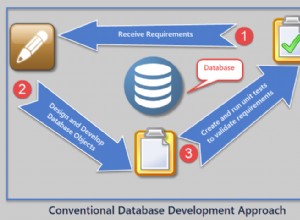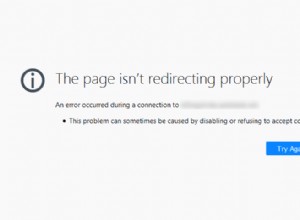Extrae la imagen como un byte[] y luego la convierte en bytes, como una cadena de caracteres hexadecimales y luego encierra esa cadena en X' su_cadena_hexadecimal '
- por ejemplo, podría ser
X'FFFEFDFCFBFA9........'
y use esa cadena como el valor para insertar a través de SQL nativo
- por ejemplo,
INSERT INTO your_table (image_column) VALUES(X'FFFEFDFCFBFA9........')
O podría usar SQliteDatbase insertar método de conveniencia, que toma un objeto Contentvalues como tercer parámetro. Configurarías el objeto Contentvalues algo similar a
ContentValues cv = new Contentvalues();
cv.put("Image",your_image_as_a_byte_array);
db.insert("the_table_name",null,cv);
Sin embargo, el almacenamiento de imágenes puede ser problemático y no se recomienda almacenar imágenes, especialmente si tienen un tamaño promedio de más de 100k.
Si una imagen está cerca de los 2M o es mayor, no podrá recuperar esa imagen utilizando la API SQLite estándar de Android, ya que CursorWindow tiene una limitación de 2M. Incluso a 1M quizás podría obtener 1 imagen dentro de una ventana de cursor.
El método recomendado es almacenar la ruta o parte de la ruta a la imagen y recuperar la imagen a través de su ruta cuando sea necesario.
Ejemplo
Dicho esto (lo anterior), la siguiente es una aplicación que almacenará la imagen en la base de datos si está por debajo de 100K (public static final int MAX_FILE_SIZE = 100 * 1024; ) o almacene la ruta y recupere la imagen a través de la ruta o la base de datos de acuerdo con lo que se almacenó.
La aplicación tiene dos ListViews con las descripciones de las imágenes (el de la derecha incluye la ruta a la imagen). Al hacer clic en un elemento en cualquiera de los dos, se muestra la imagen.
por ejemplo

Hay una cantidad de imágenes, la mayoría de más de 100k, una funny.png está por debajo de 100k :-

Las imágenes se colocaron en la carpeta Raw de la carpeta Res para este ejemplo, luego se copiaron en la carpeta data/data/files/images (donde representa el nombre del paquete de la aplicación):-

El asistente de base de datos, DBHelper.java es :-
public class DBHelper extends SQLiteOpenHelper {
public static final String DBNAME = "images.db";
public static final int DBVERSION = 1;
// The maximum size of an image that should be stored 100K
public static final int MAX_FILE_SIZE = 100 * 1024;
public static final String TB_IMAGE = "image";
public static final String COL_IMAGE_ID = BaseColumns._ID;
public static final String COL_IMAGE_PATH = "image_path";
public static final String COL_IMAGE_NAME = "image_name";
public static final String COl_IMAGE_DESCRIPTION = "image_description";
public static final String COL_IMAGE_SIZE = "image_size";
public static final String COL_IMAGE_IMAGE = "image";
SQLiteDatabase mDB;
/**
* Construct DBHelper, note that it will open the database and
* thus create it if it doesn't exist
* @param context a context from the invoking activity
*/
public DBHelper(Context context) {
super(context, DBNAME, null, DBVERSION);
mDB = this.getWritableDatabase();
}
/**
* Create the table(s)
* @param db
*/
@Override
public void onCreate(SQLiteDatabase db) {
String crtsql = "CREATE TABLE IF NOT EXISTS " + TB_IMAGE +
"(" +
COL_IMAGE_ID + " INTEGER PRIMARY KEY, " +
COL_IMAGE_PATH + " TEXT UNIQUE, " +
COL_IMAGE_NAME + " TEXT, " +
COl_IMAGE_DESCRIPTION + " TEXT, " +
COL_IMAGE_SIZE + " INTEGER, " +
COL_IMAGE_IMAGE + " BLOB DEFAULT x'00'" +
")";
db.execSQL(crtsql);
}
@Override
public void onUpgrade(SQLiteDatabase sqLiteDatabase, int i, int i1) {
}
/**
* Return a Cursor with all the rows from the image table
* @return The Cursor
*/
public Cursor getImageList() {
return mDB.query(TB_IMAGE,null,null,null,null,null,null);
}
/**
* Store an image row in the image table, noting that is the image
* size is small than the max size that the image will be stored as a blob
* otherwise a blob of 1 byte is stored due to the default value.
* @param path the path to the image
* @param description a description for the image
* @return the id (rowid) of the row
*/
public long addImageFromPath(String path, String description) {
ContentValues cv = new ContentValues();
File f = new File(path);
InputStream is;
// If the file doesn't exist don't store a row
if (!f.exists()) {
return -1;
}
// Always store the name, description, path and size
cv.put(COL_IMAGE_NAME,f.getName());
cv.put(COl_IMAGE_DESCRIPTION,description);
cv.put(COL_IMAGE_SIZE,f.length());
cv.put(COL_IMAGE_PATH,f.getAbsolutePath());
// If the size is less than the max then get the filestream
// and convert to a byte[].
// Note if larger then the max file size the default x'00' blob
// will be applied
if (f.length() < MAX_FILE_SIZE) {
byte[] buffer = new byte[(int) f.length()];
try {
is = new FileInputStream(f);
is.read(buffer);
} catch (IOException e) {
e.printStackTrace();
return -1;
}
cv.put(COL_IMAGE_IMAGE,buffer);
}
// Do the insert
return mDB.insert(TB_IMAGE,null,cv);
}
/**
* get the image as a bitmap from the DB if stored, otherwise get it from
* the file, according to the id.
* @param id the id of the row in the image table
* @return the bitmap to be returned (note may be empty bitmap)
*/
public Bitmap getImage(long id) {
byte[] ba = new byte[0];
// If the image is stored in the DB then extract and return the bitmap
if (isStoredAsImage(id)) {
return getImageAsBitMap(id);
}
// If not then get the respective row from the DB
Cursor csr = mDB.query(
TB_IMAGE,
null,
COL_IMAGE_ID+"=?",
new String[]{String.valueOf(id)},
null,
null,
null
);
// Prepare to convert the path to a file
String path = ""; //<<<< default to empty path
File f = new File(path); //<<< default to empty file
// If a valid row was found get the path and File from the row
if (csr.moveToFirst()) {
path = csr.getString(csr.getColumnIndex(COL_IMAGE_PATH));
f = new File(path);
}
// done with the cursor so close it
csr.close();
// If the file exists then return the Bitmap
if (f.exists()) {
return BitmapFactory.decodeFile(f.getAbsolutePath());
}
// return an empty bitmap
return BitmapFactory.decodeByteArray(ba,0,ba.length);
}
/**
* Check to see if an image is stored in the DB,
* note assumes anything less than 8 bytes isn't an image
* @param id the id of the row in the image table
* @return true if like an image is stored, otherwise false
*/
private boolean isStoredAsImage(long id) {
boolean rv = true;
byte[] ba = new byte[0];
// Get the respective row from the image table
Cursor csr = mDB.query(
TB_IMAGE,
null,
COL_IMAGE_ID+"=?",
new String[]{String.valueOf(id)},
null,
null,
null
);
// If a row was found get the blob into byte array ba
// if not then ready to return false
if (csr.moveToFirst()) {
ba = csr.getBlob(csr.getColumnIndex(COL_IMAGE_IMAGE));
} else {
rv = false;
}
// If the byte array ba is less then 8 bytes then ready to return false
if (ba == null || ba.length < 8) {
rv = false;
}
// done with the Cursor so close it
csr.close();
// return the result
return rv;
}
/**
* get the image (assumes isStoredAsImage is used prior to invocation)
* @param id the id of the respective row
* @return the bitmap (may be 0 length)
*/
private Bitmap getImageAsBitMap(long id) {
byte[] ba = new byte[0];
Bitmap bmp;
Cursor csr =mDB.query(
TB_IMAGE,
null,
COL_IMAGE_ID+"=?",
new String[]{String.valueOf(id)},
null,
null,
null
);
if (csr.moveToFirst()) {
ba = csr.getBlob(csr.getColumnIndex(COL_IMAGE_IMAGE));
}
csr.close();
return BitmapFactory.decodeByteArray(ba,0,ba.length);
}
}
La actividad de invocación MainActivity.java es :-
public class MainActivity extends AppCompatActivity {
public static final String IMAGES_DIRECTORY = "images";
private static File images_file;
ArrayAdapter<String> mAdapter;
ListView mListView01, mListView02;
ArrayList<String> mImages;
CursorAdapter mCsrAdapter;
Cursor mCsr;
ImageView mImageView;
DBHelper mDBHlpr;
@Override
protected void onCreate(Bundle savedInstanceState) {
super.onCreate(savedInstanceState);
setContentView(R.layout.activity_main);
// get the View/Viewgroup IDs
mListView01 = this.findViewById(R.id.listview001); // File List
mListView02 = this.findViewById(R.id.listview002); // DB List
mImageView = this.findViewById(R.id.imageview001); // Image display
// get an instance of the DBHelper
mDBHlpr = new DBHelper(this);
// Copy images from raw folder to data/data/<package>/Files/images
// Also store all the images in the Database (or not depedning upon size)
getImagesFile(this);
if (getImagesCount() < 1) {
loadRawImages();
storeImagesToDB();
}
// Setup the two ListViews to display image name lists
displayList();
displayListFromDB();
// setup the file list so that when an item is clicked the image is displayed
mListView01.setOnItemClickListener(new AdapterView.OnItemClickListener() {
@Override
public void onItemClick(AdapterView<?> adapterView, View view, int i, long l) {
String imagename = mListView01.getItemAtPosition(i).toString();
displayImage(imagename);
}
});
// setup the DB list so that when an item is clicked the image is displayed
mListView02.setOnItemClickListener(new AdapterView.OnItemClickListener() {
@Override
public void onItemClick(AdapterView<?> adapterView, View view, int i, long l) {
displayDBImage(l);
}
});
}
/**
* Store the images in the images folder to the DB giving then a calculated description
* e.g. image1, image2 .....
*/
private void storeImagesToDB() {
File f = getImagesFile(this);
File[] images = f.listFiles();
int imagecounter = 1;
for (File img: images) {
mDBHlpr.addImageFromPath(img.getPath(),"image" + String.valueOf(imagecounter++));
}
}
/**
* return the directory/folder where the images are stored as a File
* @param context a valid context
* @return the number of images
*/
public static File getImagesFile(Context context) {
if (images_file == null) {
images_file = new File(context.getFilesDir().getPath() + File.separator + IMAGES_DIRECTORY);
if (!images_file.exists()) {
images_file.mkdirs();
}
}
return images_file;
}
/**
* get the number of images
* @return the number of images
*/
public static long getImagesCount() {
File[] files = images_file.listFiles(new FileFilter() {
@Override
public boolean accept(File file) {
return file.isFile();
}
});
return (long) files.length;
}
/**
* Setup/refresh the list of images according to the images folder
* (left ListView)
*/
private void displayList() {
if (mImages == null) {
mImages = new ArrayList<>();
} else {
mImages.clear();
}
mImages.addAll(Arrays.asList(images_file.list()));
if (mAdapter == null) {
mAdapter = new ArrayAdapter<String>(this,android.R.layout.simple_list_item_1, mImages);
mListView01.setAdapter(mAdapter);
} else {
mAdapter.notifyDataSetChanged();
}
}
/**
* Set the image view according to the file
* @param imageName the name of the image (as per the ListView)
*/
private void displayImage(String imageName) {
File img = new File(images_file.getPath() + File.separator + imageName);
if (img.exists()) {
Bitmap bmp = BitmapFactory.decodeFile(img.getAbsolutePath());
mImageView.setImageBitmap(bmp);
}
}
/**
* Set the image view according to the image stored/referred to by the DB
* @param id the id of the respective row in the image table
*/
private void displayDBImage(long id) {
mImageView.setImageBitmap(mDBHlpr.getImage(id));
}
/**
* Setup/refresh the list of images as obtained from the DB (right listview)
*/
private void displayListFromDB() {
mCsr = mDBHlpr.getImageList();
if (mCsrAdapter == null) {
mCsrAdapter = new SimpleCursorAdapter(
this,
android.R.layout.simple_list_item_2,
mCsr,
new String[]{DBHelper.COL_IMAGE_NAME,DBHelper.COL_IMAGE_PATH},
new int[]{android.R.id.text1,android.R.id.text2},
0
);
mListView02.setAdapter(mCsrAdapter);
} else {
mCsrAdapter.swapCursor(mCsr);
}
}
/**
* Load (copy from raw folder to images folder) all images
*/
private void loadRawImages() {
Field[] fields = R.raw.class.getFields();
int resourceID = 0;
String resourceName;
for (Field fld: fields) {
resourceName = fld.getName();
try {
resourceID = fld.getInt(fld);
} catch (IllegalAccessException e) {
e.printStackTrace();
}
Log.d("RAW FLDINFO","name=" + fld.getName() + " ID=" + String.valueOf(resourceID));
copyResourceImageToImages(resourceID,resourceName, true);
}
}
/**
* Copy an image from the raw directory (app/src/main/res/raw directory) to
* the Apps data/data/files/images folder
* @param resourceID ID of the resource
* @param resourceName name of the resource (file name less extension)
* @param throw_exception true if an exception should be thrown
*/
private void copyResourceImageToImages(int resourceID, String resourceName, boolean throw_exception) {
String tag = "CPYRSRCTOIMAGES";
InputStream is = getResources().openRawResource(resourceID);
File of = new File(images_file.getPath() + File.separator + resourceName + ".jpg");
Log.d(tag,"Initiating Copy of File " + of.getName());
int buffer_size = 1024 * 4;
int bytesread = 0;
long bytescopied = 0;
OutputStream os;
byte[] buffer = new byte[buffer_size];
if (!of.exists()) {
try {
of.createNewFile();
} catch (IOException e) {
Log.d(tag,"Error Creating File " + of.getName());
e.printStackTrace();
if (throw_exception) {
throw new RuntimeException("Error Creating Output File" + of.getName());
}
return;
}
}
try {
os = new FileOutputStream(of);
} catch (IOException e) {
Log.d(tag,"Error Creating OutputStream for File " + of.getName());
e.printStackTrace();
if (throw_exception) {
throw new RuntimeException("Error Creating OutputStream for File " + of.getName());
}
return;
}
if (os == null) {
throw new RuntimeException("OutputStream not initialised.");
}
try {
while ((bytesread = is.read(buffer)) > 0 ){
try {
os.write(buffer, 0, bytesread);
} catch (IOException e) {
String msg = "Error Writing to Output File " + of.getName() + " Bytes Copied = " + bytescopied;
Log.d(tag, msg);
e.printStackTrace();
if (throw_exception) {
os.close();
of.delete();
throw new RuntimeException(msg);
}
is.close();
os.close();
of.delete();
return;
}
bytescopied = bytescopied + bytesread;
}
}catch (IOException e) {
String msg = "Error reading Input File " + resourceName + " Bytes Copied = " + bytescopied;
Log.d(tag,"Error Reading Input File " + resourceName);
e.printStackTrace();
if (throw_exception) {
throw new RuntimeException(msg);
}
try {
is.close();
os.close();
of.delete();
} catch (IOException e2) {
e2.printStackTrace();
}
}
Log.d(tag,"File " + of.getName() +" Copied - Bytes Successfully Copied = " + bytescopied);
try {
os.flush();
} catch (IOException e) {
e.printStackTrace();
}
try {
os.close();
} catch (IOException e) {
e.printStackTrace();
}
try {
is.close();
} catch (IOException e) {
e.printStackTrace();
}
}
}




